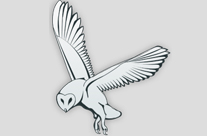Posted by Michael Haran on Apr 20, 2010
Scuppernong; Norton; Seyval Blanc; Not the normal wines you’d expect at a wine tasting but this was not a normal California wine tasting. For the second year the Atlantic Seaboard Wine Association (ASWA) was invited to pour some of the Association’s 2009 competition award winning East Coast wines at the 2010 Unified Wine and Grape Symposium in Sacramento. During their trip to the West Coast the group was asked by Anne Vercelli, a local food and wine educator, and Bo Simons, head librarian of Healdsburg’s Sonoma County Wine library to present an historical wine seminar. The event included the tasting of some of the 22 different east coast wines shippe d out for the events.
d out for the events.
Because of its industry dominance, many people associate the history of American wines with California. The fact is the first American wines were made in the late 1500s from species of Native American wine grapes. Native American grapes were so plentiful along the Eastern United States that the name first given to North America by the Vikings was Vinland. In comparison, the first California winery was established in San Juan Capistrano in 1783 by the Franciscan missionaries.
Gordon Murchie, ASWA’s President Emeritus, told the some 60 wine enthusiasts that attended the Healdsburg event, about America’s first introduction to wine production. Being a retired U.S. State Department official, Mr. Murchie has a broad knowledge of U.S. history and his entertaining story telling made for a fun evening. For show and tell he even brought some very old wine bottles from the Jamestown Virginia Colony from the 17th century.
The earliest wine made in what is now the United States was more than likely from the Scuppernong grapes by French Huguenot settlers at a settlement near Jacksonville, Florida between 1562 and 1564. In the early American Colonies of Virginia and the Carolinas, wine making was an official goal laid out in their founding charters. However, settlers would later discover that the wine made from the various native grapes had flavors which were unfamiliar and often referred to as “foxy” or earthy in taste unlike European wines which limited their popularity.
This led to repeated efforts to grow familiar Vitis vinifera varieties beginning with the Virginia Company exporting of French vinifera vines to Virginia in 1619. These early plantings were met with failure as native pests, vine disease brought on by hot, humid summers and the cold of winter that ravaged the vineyards.
In 1683, William Penn planted a vineyard of French vinifera in Pennsylvania that may have interbred with a native Vitis labrusca vine to create the hybrid grape Alexander. One of the first commercial wineries in the United States was founded in Indiana in 1806 with production of wine made from the Alexander grape. Today French-American hybrid grapes still represent a significant sector of wine production on the U.S. East Coast.
The primary Native American east coast grape species are Vitis labrusca, Vitis rotundifolia, Vitis aestivalis, and the best know Native American species Vitis riparia. Vitis labrusca’s Concord grape is used in jelly, juice a nd soft drinks and it was the Vitis labrusca’s root stock that saved the Phylloxera ravaged French vinifera grapes in the late 19th century.
nd soft drinks and it was the Vitis labrusca’s root stock that saved the Phylloxera ravaged French vinifera grapes in the late 19th century.
Some of the varietals that are made from the native vines include Scuppernong (it gets my vote for the best east coast wine name), Concord, Catawba and Niagara. From the start to the 1930’s the only wine made on the East Coat came from the native grapes. Because they could more resemble vinifera wines, in the 1930’s the French Hybrids took over from the native vines. The best know of these varietals include Norton, Chambourcin, Marechal Foch, Vidal Blanc, and Seyval Blanc. With the advances in viticulture by the 1950’s the vinifera varietals began to take hold.
Today, many fine vinifera wines are being made on the East Coast. As an example, the largest American wine competition, The San Francisco Chronicle Wine Competition, the largest American wine competition in the world, awarded the up-state New York Finger Lakes Keuka Springs Vineyards 2008 Gewurztraminer the best white wine in the country.
And now the wines.
I really didn’t know what to expect. Being born and bread in California I only knew wines of the Vitis vinifera persuasion. Growing up I knew, as we all did, of the Concord grape (Vitis labrusca) because of Welsh’s grape jelly, juice and soft drinks. The only other thing I knew was that wines made on America’s east coast were considered inferior to those made on the west coast.
The first wine poured was the Native American varietal Scuppernong from Duplin Wines Cellars in North Carolina. It has historically has been grown in the southeastern U.S. Also know as Muscadinia or Muscadine, this Scuppernong was crystal clear, sweet and with strong floral aromas.
The next wine was a fortified vinifera Madeira from the island of the same name near Portugal. Since it’s not an east coast wine I won’t go into it but as an aside Madeira was used by our founding fathers to toast our Declaration of Independence in 1776
Next up was the Virginia hybrid Norton which is believed to be across between aestivalis and vinifera. A small, deep blue-black grape, the Norton varietal gives intense color, body with strong herbaceous characteristics which includes spice, fruitiness, aroma of plumb and tart cherries, black pepper, tobacco and chocolate.
The Chambourcin grape is one of the more successful French Hybrids which ripens late in the season. The varietal, which can produce rose and Beaujolais style wines, is known for a distinct aroma of herbaceous flavors including raspberry, clove, cherry, plum and tobacco.
The second white poured was the Virginia, 2008 Lake Anne Winery Seyval Blanc which is one of the more commercially successful east coast French Hybrids. This wine is reminiscent of the Vinifera Sauvignon Blanc in that it boasts of aromas of grass, hay, green apples and juicy pears with a nice clean finish.
The last wine tasted was a wine called Octagon which is a classic Bordeaux Vinifera Blend of Cabernet Sauvignon, Merlot, Cabernet Franc and Petit Verdot. All of the grapes of this 2005 blend were grown in the Barboursville vineyards, Virginia. A bit tannic the winery advises that this vintage should be put down for five years to reach a flavor peak around 2012. This wine boasts of an intense aroma of plum, cassis, coffee and berries.
For the most part everyone at the event had a positive reaction to the east coast wines. Some of the native varietals took a little getting used to but not in a “bad” way only a “different” way. I personally though the Bordeaux blend was a good as any California blend but there were a few wines in the lineup that seemed to lack a certain balance and maybe had some oxidation problems. Virginia wines have come a long way from ten years ago.
As the quality of the east coast wines has improved the future of the industry will be in their native/hybrid and the “cold weather” vinifera varietals such as Riesling and Gewürztraminer. Since this is the only place in the world that these American Native/French Hybrid wines are produced as they get known around the world the niche market for these wines can only grow.
Read More
Posted by Michael Haran on Sep 15, 2009
HEALDSBURG’S FIRST WINERIES
Published in the Healdsburg Museum’s Russian River Recorder
Autumn 2009
by Michael Haran
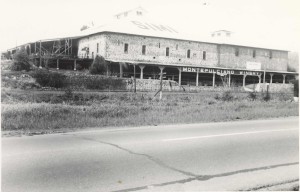
Montepulciano Winery
It seems fitting that during our annual grape harvest, we take a look at the early history of the industry that wines, dines and supports our town. Not only does Sonoma’s wine industry account for about 40% ($20 billion) of our county’s annual gross income but it has also fostered other businesses such as the one billion dollar per year tourism industry. All of this has transformed Healdsburg (like it or not) into an up scale market including designer shops, restaurants and hotels with full service spas. One wonders what George Miller would think of all this.
Prior to George Miller Sr. establishing Healdsburg’s first commercial winery, wine was made by many small home producers for their personal use and as part of the barter system which was prevalent in NorthernSonomaCounty before the establishment of banks and the beginning of our modern economy. In a letter from Lindsay Carson (brother of famed explorer Kit Carson) to his great-grandfather in 1857, he wrote “money is scarcer than I have ever known.”
It seems that one of the first things any European settler did here was to plant grapes. The Russian’s at FortRoss are credited with the establishment of the first vineyards. The Franciscans at the Sonoma Mission first planted grape vine in 1823 about five years after the Russians planted their first vineyard. Most of the early vineyards featured Mission grapes. In 1860, Davenport Cousins was listed as the first wine producer in the DryCreekValley. His ranch, which is now the site of the Ferrari-Carano Winery (8761 Dry Creek Road) featured a post office, saloon and grocery store. The site was known as Cozzens Corner and was operated by Cozzens and his son for some thirty years.
In 1864, A.J. Galloway was credited with establishing DryCreekValley’s first vineyard. Gene Cuneo, felt that Galloway’s vineyard, which is now the Cuneo Ranch (2470 Dry Creek Road, was primarily planted in Zinfandel. To give some idea of the grape varietals being grown in the area in 1883: 395 acres were planted to Zinfandel; 240 acres to Mission; 64 acres to Malvoise; 50 acres to Golden Chasselas; 18 acres to White Reisling; and 40 acres to other varietals.
As an aside, it is interesting to note how land values, today by far the most costly element of any vineyard, of the period were little more than an incidental. The following is an actual cost accounting reported by Agoston Haraszthy (founder of Buena Vista Winery) when he planted 100 acres in January 1858:
Six men with nine horses for deep tillage
and six horses for shovel plow $231.60
Horse hire and feed 255.00
Blacksmith 30.00
18 men to layout, stake,
Dig holes and plant vines 892.68
Cost of land 170.00
Miscellaneous 55.36
Total $1,634.64
It is believed that Healdsburg’s first commercial winery was established in 1862, during the Civil War, by George Miller Sr. A native Swiss, Miller came to SonomaCounty in 1853. He was first a partner in his uncle Felta Miller’s (along with Samuel and Thomas Heald) saw and grist mill located on Mill Creek off of Westside Road.
Of interest, it was local lore that Catherine “Katie” Miller, Felta’s wife, was a problem. This story is one of Sonoma Counties most told legends and tales. It seems Katie liked her hooch. Felta would often hide the “jug” from Katie who was known to appear at the back door of some of Healdsburg’s early saloons. Felta and some friends were leaving for a Fourth of July celebration in 1854, and he was concerned as to how to conceal a keg of whiskey that was in the house. Felta got an idea. He had one of his friends climb a tree and, unseen by Katie, tied it securely out of reach. After a diligent search she spotted the “treasure” high in the tree. After diligent thought she came up with a brilliant solution. She carried out a large washtub and placed it directly beneath the keg. Procuring her husband’s rifle she peppered the keg with several bullet holes. Katie was found by the returning party in close proximity to her favorite tipple, having had as much “independence” as was good for her.
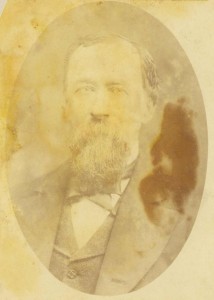
George Miller
When Miller sold his interest back to his uncle, he and his wife Ursula bought about 12 acres that is bordered today by College, University, Grant and Powell Streets from the estate of Colonel Rod Matheson who was killed in an 1862 Civil War battle. After clearing, he planted eight acres in Mission and Hamburg grapes (6.5 to Mission and 1.5 to Hamburg) with the remaining four acres (the southeast corner of the property) reserved for the construction of the distillery and family home. The name of the winery was the Healdsburg Fruit Distillery, which produced “Quality wines and brandies distilled from grapes, apples and peaches.” Both Ursula and his daughter Celia (who was Healdsburg’s May Queen in 1869) worked the winery with Miller.
Some time before 1867 Miller moved the winery to the southeast corner of West (now Healdsburg Ave.) and Grant Street. He may have also taken in a partner during this time. A man named Mr. Fried was said to have worked with Miller at the winery, but no further record of him can be found.
The coming of the railroad in 1871 brought Healdsburg a boom in prosperity. With the trip from San Francisco now taking only four hours, the tourist trade took a sharp up turn, as did the sale of agricultural products to the now easily accessible Bay Area markets. In 1872 George Bosch and Alex Colson opened the first Dry Creek winery and produced quality wines from their 14 acres (around 1500 Dry Creek Road) of Mission and Zinfandel grapes. The Zinfandel grape had arrived from the East Coast during the Gold Rush and was first used as a table grape in San Francisco.
In 1873, a Frenchman named John Chambaud built a stone winery along the north side of Hudson Street, a little west of Front Street (one wall of the original building is still standing as part of the office building that currently occupies the site). It can be argued that Chambaud’s winery was the first in Healdsburg since this winery was actually within the city limits, whereas Miller’s first location was not. Chambaud grew none of his own grapes. His winery’s 20,000 gallon capacity was welcomed by the local grape growers. Vineyards were growing rapidly in the area and not all the grapes could be sold in the San Francisco market. Chambaud bought and crushed (using mostly Chinese labor) 200 tons of grapes for his first vintage.
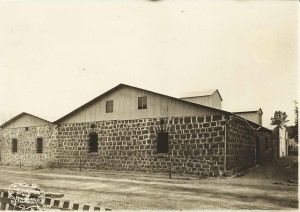
Chambaud Winery circa 1909
In the first half of the 1870’s several factors led to the first boom in Sonoma County’s wine industry (a cycle that’s been repeated ever since). First, the coming of the Transcontinental Railroad in 1869 opened up the Eastern U.S. markets; second, the French Phylloxera epidemic opened the European market to California wines for the first time. This caused a boom in both grape growing and wine making. In 1873 California wine production jumped 40% to 2,636,000 gallons. In the same year, Healdsburg’s wine was selling for 30 cents per gallon and brandy was selling for $1.50 per gallon. By 1876 the price of wine dropped to 10 cents per gallon.
In 1877, Miller sold his winery to Mr. A.E.S. DeWiederhold (a winemaker from British Columbia), but kept his home and the 12 acres of grapes. Miller then opened a butcher shop in downtown Healdsburg. He gradually transplanted his old Mission vines and had a vineyard of desirable dry red varieties by the early 1890s. DeWiederhold changed the name to the Fairview Winery.
The depression of 1876 forced John Chambaud to sell his winery to a cooperative group of vineyards organized as “The United Vineyard Proprietors Company” for $4,000. Chambaud stayed on as foreman until he moved to Cloverdale in 1880. The cooperative changed the name of the winery from Chambaud Winery to the Healdsburg Winery.
The depression of the mid 1870s set the stage for a dramatic rebound in the early 1880s. In 1877, Chambaud produced about 20,000 gallons of wine; Miller produced about 5,000 gallons; and Bloch & Colson produced about 5,000 gallons. In 1882, the Healdsburg region wine produced was 382,000 gallons. The Simi and the Gobbi brothers timing was perfect.
Pietro and Giuseppe Simi bought the Healdsburg (Chambaud) Winery in 1881 just in time for the next boom in the SonomaCounty wine industry. Giuseppe Simi arrived in California from his native Tuscany in 1859 and work for a time as a miner and later a produce farmer renting 2,800 acres of land in SacramentoCounty, 1,840 acres in KernCounty and 1,600 near Pescadero. Pietro sold the produce and made wine in their building at 429 Green Street in San Francisco.
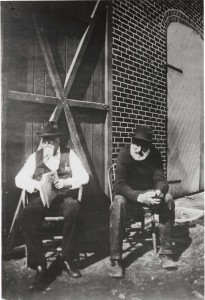
Pietro and Giuseppe Simi
In 1868, Giuseppe moved to Healdsburg to buy grapes for the brother’s San Francisco winery. After they bought the Healdsburg Winery and, catching the wine boom, soon out grew the Hudson Street location. In 1883, Giuseppe bought 126 acres just north of Healdsburg. They cleared the land and planted 116 acres of mostly Zinfandel. They built a stone winery on the site and named it Montepulciano in honor of the Tuscan winegrowing town where they were born. The annual out put was 70,000 gallons of wine through the 1890s. Giuseppe was always in charge of the winery, while Pietro ran the business in San Francisco. The Simi Winery is the longest continuing running winery in the Healdsburg area.
Meanwhile, DeWiederhold sold the Fairview Winery to Peter and B. Gobbi in 1882. Gobbi renamed it the Sotoyome Winery and moved it to the 300 block of West Street (Healdsburg Ave.). In 1884, a cousin, Julius Gobbi bought out B. Gobbi. They made about 60,000 gallons of wine annually and their wines had a “fine reputation, which commands ready sale in San Francisco as soon as prepared for the market. They also manufacture grape brandies, and the product of their distillery never has to wait for a market.”
Both cousins were from an Italian town named Dongo which is near the northern end of LakeComo. Both men’s fathers were vineyardists and wine producers. In 1869, Julius’ family moved to Ukiah where his father planted a vineyard. This is where Julius learned the business of vine growing and the rudiments of wine-making. Peter came to California in 1873 and worked in the dairy business in Petaluma and Bloomfield until he moved to Healdsburg and bought the Fairview Winery.
In the 1880’s Peter and Julius built a commercial building at 312 Center Street which still bears their name. Peter retired in 1895, but Julius ran the operation for some years to come. Both men had a fine reputation and were active in the Healdsburg community.
DeWiederhold kept his vineyard and built a small private winery that was maintained by his widow, Alice, until 1892, when it burned down. This was one of the numerous temperance movement winery fires around this date and was presumed the work of the fanatic “Drys.”
Today there are over 350 bonded wineries in SonomaCounty with eleven distinct and two shared American Viticulture Areas including the RussianRiverValley, AlexanderValley, and DryCreekValley, the last of which is known for the production of high-quality Zinfandels.
In 2007 the SonomaCounty grape harvest amounted to over 198,000 tons, exceeding NapaCounty’s harvest by just under 30 percent. About 80% of non-pasture agricultural land in the county is for growing wine grapes—63,825 acres of vineyards with over 1800 growers. The most common varieties planted are Chardonnay, Cabernet Sauvignon, Pinot Noir, Merlot and Zinfandel. The overall 2007 average price per ton was $2,081 up 5% from 2006.
Photos courtesy of Healdsburg Museum
Read More
 d out for the events.
d out for the events. nd soft drinks and it was the Vitis labrusca’s root stock that saved the Phylloxera ravaged French vinifera grapes in the late 19th century.
nd soft drinks and it was the Vitis labrusca’s root stock that saved the Phylloxera ravaged French vinifera grapes in the late 19th century.


